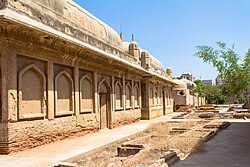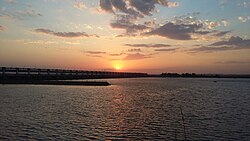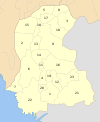Hyderabad District, Sindh
25°15′N 68°45′E / 25.250°N 68.750°E
Hyderabad district
| |
|---|---|
 Map of Sindh with Hyderabad District highlighted | |
| Country | |
| Province | |
| Division | Hyderabad |
| Established | 1843 |
| Founded by | British government |
| Headquarters | Hyderabad |
| Government | |
| • Type | District Administration |
| • Deputy Commissioner | N/A |
| • District Police Officer | N/A |
| • District Health Officer | N/A |
| Area | |
| 1,740 km2 (670 sq mi) | |
| Population | |
| 2,432,540 | |
| • Density | 1,400/km2 (3,600/sq mi) |
| • Urban | 2,022,379 (83.14%) |
| • Rural | 410,161 |
| Time zone | UTC+5 (PKT) |
| Number of Tehsils | 4 |
| Website | www.hyderabad.gov.pk |
Hyderabad District (Sindhi: ضلعو حيدرآباد Urdu: ضلع حیدرآباد),ⓘ is a district of Sindh, Pakistan. Its capital is the city of Hyderabad. The district is the second most urbanized in Sindh, after Karachi, with 80% of its population residing in urban areas.[2]
History
[edit]The East India Company occupied Sindh in 1843. They formed three districts in Sindh administratively: Hyderabad, Karachi and Shikarpur.
In 1901, a new taluka named Nasrat was created from Sakrand and Shahdadpur talukas.[3]
In 1912, the northern side of the district separated to form Nawabshah district.[4]
In 1975, the southern side also separated to form Badin district.
After the 1998 census, two new talukas were created in the district named; Hyderabad city and Latifabad talukas.
After the 2002 elections, a new taluka was created in the district named Qasimabad from Hyderabad City taluka.
The city of Hyderabad is where the district headquarters were located and the district government used to be seated. The last Deputy Commissioner of the district was Rizwan Ahmed. Until the early 1970s the district included all the four districts mentioned above as well as the Badin district. This administrative setup was demolished by former President Pervez Musharraf in 2001 when he introduced the local body government.
In 2005, three new districts - Tando Muhammad Khan, Matiari and Tando Allahyar districts were formed out of Hyderabad district.[5]
Geography
[edit]Hyderabad District is 104,877 hectares in size.[6] 14,250 hectares of the district are under wheat cultivation, with a total annual production of over 55,000 tonnes.[6]
Administration and government
[edit]The district Administration is given below:
Demographics
[edit]| Year | Pop. | ±% p.a. |
|---|---|---|
| 1951 | 319,232 | — |
| 1961 | 537,000 | +5.34% |
| 1972 | 814,060 | +3.85% |
| 1981 | 1,005,460 | +2.37% |
| 1998 | 1,494,866 | +2.36% |
| 2017 | 2,199,928 | +2.05% |
| 2023 | 2,432,540 | +1.69% |
| Sources:[8] | ||
At the time of the 2017 census, Hyderabad had a sex ratio of 921 females per 1000 males and a literacy rate of 65.76%: 69.91% for males and 61.23% for females. 373,410 (16.97%) lived in urban areas. 541,027 (24.59%) were under 10 years of age.[9] In 2023, the district had 448,479 households and a population of 2,432,540.[1]
Religion
[edit]The majority religion is Islam, with 90.67% of the population. Hinduism (including those from Scheduled Castes) is practiced by 8.32%, while Christianity is practiced by 0.95% of the population.[11]
| Religious group | 1941[12]: 52–53 | 2017[9] | 2023[11] | |||
|---|---|---|---|---|---|---|
| Pop. | % | Pop. | % | Pop. | % | |
| Hinduism | 115,015 | 53.51% | 180,926 | 8.22% | 202,368 | 8.32% |
| Islam | 97,762 | 45.48% | 1,998,896 | 90.86% | 2,205,523 | 90.67% |
| Sikhism | 1,587 | 0.74% | — | — | 75 | 0% |
| Christianity | 355 | 0.17% | 18,975 | 0.86% | 23,019 | 0.95% |
| Others [a] | 214 | 0.10% | 1,131 | 0.06% | 1,555 | 0.06% |
| Total Population | 214,933 | 100% | 2,199,928 | 100% | 2,432,540 | 100% |
| Note: 1941 census data is for Hyderabad taluk of Hyderabad District, which roughly corresponds to contemporary Hyderabad District. District and taluk borders have changed since 1961. | ||||||
| Religious group | 1872[13] | 1881[14] | 1891[15] | 1901[16] | 1911[17] | 1921[4] | 1931[18] | 1941[19] | |||||||||||
|---|---|---|---|---|---|---|---|---|---|---|---|---|---|---|---|---|---|---|---|
| Pop. | % | Pop. | % | Pop. | % | Pop. | % | Pop. | % | Pop. | % | Pop. | % | Pop. | % | ||||
| Islam | 558,272 | 77.33% | 594,485 | 78.78% | 713,000 | 77.61% | 744,632 | 75.29% | 781,219 | 75.32% | 411,776 | 71.81% | 460,920 | 69.53% | 507,620 | 66.9% | |||
| Hinduism | 163,222 | 22.61% | 159,515 | 21.14% | 204,785 | 22.29% | 242,692 | 24.54% | 246,008 | 23.72% | 160,211 | 27.94% | 198,684 | 29.97% | 245,849 | 32.4% | |||
| Christianity | 391 | 0.05% | 428 | 0.06% | 778 | 0.08% | 747 | 0.08% | 1,130 | 0.11% | 1,054 | 0.18% | 771 | 0.12% | 580 | 0.08% | |||
| Zoroastrianism | 45 | 0.01% | 21 | 0% | 46 | 0.01% | 89 | 0.01% | 96 | 0.01% | 57 | 0.01% | 31 | 0% | 30 | 0% | |||
| Judaism | 17 | 0% | 31 | 0% | 32 | 0% | 10 | 0% | 15 | 0% | 0 | 0% | 10 | 0% | 14 | 0% | |||
| Jainism | — | — | 144 | 0.02% | 0 | 0% | 119 | 0.01% | 171 | 0.02% | 82 | 0.01% | 187 | 0.03% | 217 | 0.03% | |||
| Buddhism | — | — | 0 | 0% | 0 | 0% | 0 | 0% | 0 | 0% | 0 | 0% | 0 | 0% | 0 | 0% | |||
| Sikhism | — | — | — | — | 3 | 0% | — | — | 3,073 | 0.3% | 270 | 0.05% | 2,205 | 0.33% | 3,669 | 0.48% | |||
| Tribal | — | — | — | — | — | — | — | — | 5,432 | 0.52% | 0 | 0% | 0 | 0% | 769 | 0.1% | |||
| Others | 0 | 0% | 0 | 0% | 2 | 0% | 741 | 0.07% | 0 | 0% | 0 | 0% | 116 | 0.02% | 0 | 0% | |||
| Total population | 721,947 | 100% | 754,624 | 100% | 918,646 | 100% | 989,030 | 100% | 1,037,144 | 100% | 573,450 | 100% | 662,924 | 100% | 758,748 | 100% | |||
| Note1: British Sindh era district borders are not an exact match in the present-day due to various bifurcations to district borders — which since created new districts — throughout the region during the post-independence era that have taken into account population increases. Note2: Population decrease between 1911 and 1921 censuses due to bifurcation of district, and creation of Nawabshah District. | |||||||||||||||||||
Language
[edit]At the time of the 2023 census, 45.92% of the population spoke Urdu, 43.12% Sindhi, 3.12% Punjabi and 2.83% Pashto as their first language. The majority of Urdu speakers live in Hyderabad city and its suburbs, where they form a majority, while Sindhi dominates rural areas. Muhajirs arrived in Hyderabad after Partition.[20]
List of Dehs
[edit]The following is a list of Hyderabad District's dehs, organised by taluka:[21]
- Hyderabad Taluka (70 dehs)
- Abri
- Agheemani
- Almani
- Alni
- Amilpur
- Barechani
- Barham
- Bhido Jagar
- Bhido Rayati
- Bhinpur
- Bilori
- Bohiki
- Boochki Jagir
- Boochki Rayati
- Buxo laghari
- Chacha Detha
- Chukhi
- Dachrapur
- Dali Nandi
- Dali Wadi
- Damanchani Rayati
- Dhamanchani Jagir
- Ghaliyoon
- Ghotana
- Gujjan
- Gul Mohd Thoro
- Halepota
- Hatri
- Hotki
- Hussain Khan Thoro
- Kajhur
- Kathri
- Kathro
- Khanpota
- Khunjejani
- Kunner
- Lashari
- Liyar Jagir
- Mati
- Miyano
- Moharo
- Moolan
- Mori Jagir
- Mori Rayati
- Mulki
- Narejani
- Noorai Jagir
- Noorai Rayati
- Panhwari
- Pasaikhi
- Patbhari
- Patoro
- Raees
- Rahooki
- Rajpari
- Rukanpur
- Sahita
- Sanhwar
- Seri Jagir
- Seri Rayati
- Sipki Jagir
- Sipki Rayati
- Sukhpur
- Takio Jeewan Shah Jagir
- Takio Jeewan Shah Rayati
- Tando Fazal
- Tando Qaiser
- Thaheem
- Theba
- Widh
- Qasimabad Taluka (4 dehs)
- Jamshoro
- Mirzapur
- Sari
- Shah Bukhari
- Latifabad Taluka (10 dehs)
- Bora reyati
- Ganjo Takar
- Giddu Bandar
- Goondar
- Khater
- Lakhi Keti
- Malh
- Mehrani
- Met Khan
- Nareja
- Hyderabad City Taluka (4 dehs)
- Foujgah
- Ghanghra
- Gujjo
- Hyderabad
See also
[edit]Notes
[edit]- ^ Including Jainism, Christianity, Buddhism, Zoroastrianism, Judaism, Ad-Dharmis, or not stated
- ^ 1872 census: Also includes Tribals, Jains, Buddhists, and Nanakpanthis (Sikhs).
1881 census: Also includes Tribals and Nanakpanthis (Sikhs).
1891 census: Also includes Tribals.
1901 census: Also includes Tribals and Nanakpanthis (Sikhs).
References
[edit]- ^ a b "TABLE 1 : HOUSEHOLDS, POPULATION, HOUSEHOLD SIZE AND ANNUAL GROWTH RATE" (PDF). www.pbscensus.gov.pk. Pakistan Bureau of Statistics. 2023.
- ^ Azfar, Sara. "SINDH SECONDARY CITIES URBAN SECTOR ASSESSMENT" (PDF). URBAN MUNICIPAL SERVICES. ASIAN DEVELOPMENT BANK. Archived from the original (PDF) on 26 February 2017. Retrieved 15 December 2017.
- ^ Cheesman, David (2013-12-16). Landlord Power and Rural Indebtedness in Colonial Sind. Routledge. doi:10.4324/9781315026732. ISBN 978-1-136-79449-0.
- ^ a b India Census Commissioner (1921). "Census of India 1921. Vol. 8, Bombay Presidency. Pt. 2, Tables : imperial and provincial". JSTOR saoa.crl.25394131. Retrieved 15 December 2024.
- ^ "Three new districts carved out of Hyderabad". TheDawn. 5 April 2005. Retrieved 31 July 2021.
- ^ a b Siyal, Altaf Ali (January 2015). "Remote Sensing and GIS based wheat crop acreage and yield estimation of district Hyderabad, Pakistan". Mehran University Research Journal of Engineering and Technology. Retrieved 14 December 2017.
- ^ "Tando Jam ٹندو جام - Latest News, Photos, Videos & Local Events of Tando Jam". UrduPoint. Retrieved 2024-02-20.
- ^ "Population by administrative units 1951-1998" (PDF). Pakistan Bureau of Statistics.
- ^ a b "District Wise Results / Tables (Census - 2017)". www.pbscensus.gov.pk. Pakistan Bureau of Statistics.
- ^ a b "District Wise Results / Tables (Census - 2023)" (PDF). www.pbscensus.gov.pk. Pakistan Bureau of Statistics. Cite error: The named reference "2023 census" was defined multiple times with different content (see the help page).
- ^ a b "Pakistan Census 2023" (PDF).
- ^ "CENSUS OF INDIA, 1941 VOLUME XII SINDH PROVINCE" (PDF).
- ^ "Census of the Bombay Presidency, taken on the 21. February 1872". Bombay, 1875. 1872. p. 76. JSTOR saoa.crl.25057641. Retrieved 15 December 2024.
- ^ "Census of India, 1891. Operations and results in the Presidency of Bombay, including Sind". 1881. p. 3. JSTOR saoa.crl.25057678. Archived from the original on 1 June 2024. Retrieved 15 December 2024.
- ^ India Census Commissioner (1891). "Census of India, 1891. Vol. VIII, Bombay and its feudatories. Part II, Imperial tables". JSTOR saoa.crl.25352815. Retrieved 15 December 2024.
- ^ India Census Commissioner (1901). "Census of India 1901. Vols. 9-11, Bombay". JSTOR saoa.crl.25366895. Retrieved 15 December 2024.
- ^ India Census Commissioner (1911). "Census of India 1911. Vol. 7, Bombay. Pt. 2, Imperial tables". JSTOR saoa.crl.25393770. Retrieved 15 December 2024.
- ^ India Census Commissioner (1931). "Census of India 1931. Vol. 8, Bombay. Pt. 2, Statistical tables". JSTOR saoa.crl.25797128. Retrieved 15 December 2024.
- ^ India Census Commissioner (1941). "Census of India, 1941. Vol. 12, Sind". JSTOR saoa.crl.28215545. Archived from the original on 29 January 2023. Retrieved 15 December 2024.
- ^ "Pakistan Census 2023" (PDF).
- ^ "List of Dehs in Sindh" (PDF). Sindh Zameen. Retrieved 22 March 2021.
Bibliography
[edit]- 1998 District census report of Hyderabad. Census publication. Vol. 59. Islamabad: Population Census Organization, Statistics Division, Government of Pakistan. 1999.


 French
French Deutsch
Deutsch

